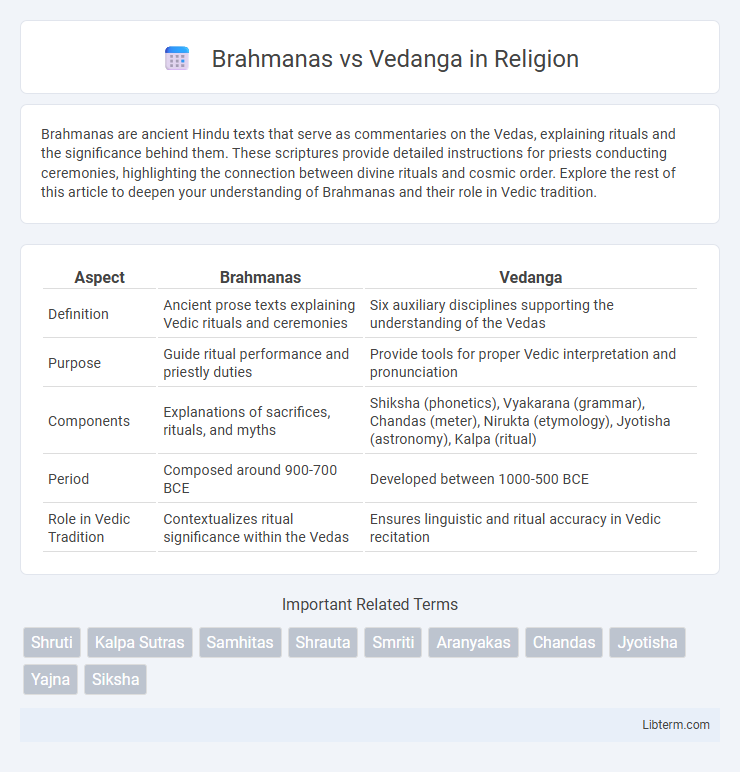Brahmanas are ancient Hindu texts that serve as commentaries on the Vedas, explaining rituals and the significance behind them. These scriptures provide detailed instructions for priests conducting ceremonies, highlighting the connection between divine rituals and cosmic order. Explore the rest of this article to deepen your understanding of Brahmanas and their role in Vedic tradition.
Table of Comparison
| Aspect | Brahmanas | Vedanga |
|---|---|---|
| Definition | Ancient prose texts explaining Vedic rituals and ceremonies | Six auxiliary disciplines supporting the understanding of the Vedas |
| Purpose | Guide ritual performance and priestly duties | Provide tools for proper Vedic interpretation and pronunciation |
| Components | Explanations of sacrifices, rituals, and myths | Shiksha (phonetics), Vyakarana (grammar), Chandas (meter), Nirukta (etymology), Jyotisha (astronomy), Kalpa (ritual) |
| Period | Composed around 900-700 BCE | Developed between 1000-500 BCE |
| Role in Vedic Tradition | Contextualizes ritual significance within the Vedas | Ensures linguistic and ritual accuracy in Vedic recitation |
Introduction to Brahmanas and Vedanga
Brahmanas are ancient prose texts associated with the Vedas that provide explanations of rituals, ceremonies, and the symbolic meaning behind Vedic hymns, playing a crucial role in preserving Vedic traditions. Vedanga consists of six auxiliary disciplines--Shiksha, Kalpa, Vyakarana, Nirukta, Chandas, and Jyotisha--developed to support the proper understanding, pronunciation, and interpretation of the Vedic texts. Both Brahmanas and Vedanga are essential for interpreting Hindu scriptures, with Brahmanas focusing on ritualistic practices and Vedanga providing linguistic and scientific tools for Vedic study.
Historical Background
Brahmanas represent ancient Sanskrit texts serving as prose commentaries on the rituals and hymns found in the Vedas, primarily composed between 900 and 700 BCE during the late Vedic period. Vedangas, developed around the same era, comprise six auxiliary disciplines including phonetics, grammar, and astronomy, essential for understanding and preserving Vedic knowledge. Together, Brahmanas and Vedangas reflect the scholarly efforts to systematize ritual practices and linguistic precision in early Vedic civilization.
Origin and Development
Brahmanas originated around 900-700 BCE as prose texts elaborating Vedic rituals and ceremonies associated with the Samhitas, reflecting the ritualistic and priestly tradition of early Vedic culture. Vedangas, comprising six disciplines such as phonetics (Shiksha), grammar (Vyakarana), and astronomy (Jyotisha), developed later to support the understanding and preservation of Vedic texts, emerging between 800-200 BCE. The Brahmanas emphasize ritual exegesis and priestly duties, while Vedangas provide technical knowledge to ensure the accurate transmission and interpretation of the Vedas.
Core Concepts and Purpose
Brahmanas are ancient Indian texts that primarily focus on explaining the rituals, ceremonies, and symbolic meanings within the Vedas, serving as a guide for priests in performing sacred rites accurately. Vedangas, meaning "limbs of the Veda," consist of six auxiliary disciplines--Shiksha (phonetics), Kalpa (ritual instructions), Vyakarana (grammar), Nirukta (etymology), Chandas (meter), and Jyotisha (astronomy)--designed to support the proper understanding, recitation, and interpretation of the Vedic texts. While Brahmanas emphasize ritualistic practice and mythological explanations, Vedangas provide the foundational tools necessary for preserving the linguistic, phonetic, and contextual integrity of the Vedic corpus.
Structure and Content
Brahmanas are prose texts primarily explaining the rituals, ceremonies, and symbolic meanings of the Vedas, structured with detailed instructions and mythological narratives. Vedangas consist of six auxiliary disciplines--Shiksha, Kalpa, Vyakarana, Nirukta, Chandas, and Jyotisha--organized as technical manuals supporting Vedic understanding and pronunciation. While Brahmanas focus on ritual interpretation and liturgical context, Vedangas provide linguistic, phonetic, and astronomical tools essential for mastering the Vedic corpus.
Role in Vedic Literature
Brahmanas play a crucial role in Vedic literature by serving as prose texts that explain the rituals and ceremonies prescribed in the Samhitas, providing detailed guidance on the performance of yajnas (sacrifices). Vedangas, consisting of six auxiliary disciplines including Shiksha (phonetics), Kalpa (ritual procedures), and Vyakarana (grammar), support the understanding and correct interpretation of Vedic texts, ensuring their accurate transmission and application. Together, Brahmanas elaborate on ritualistic practices while Vedangas offer the linguistic and procedural tools essential for preserving the integrity of Vedic knowledge.
Philosophical Differences
Brahmanas and Vedanga represent distinct aspects of Vedic literature, where Brahmanas primarily provide ritual explanations and mythological interpretations, emphasizing the symbolic and spiritual significance of Vedic rites. Vedangas, in contrast, consist of six auxiliary disciplines--Sanskrit grammar, phonetics, metrics, astronomy, etymology, and ritual instruction--designed to support the understanding and precise execution of Vedic texts and rituals. Philosophically, Brahmanas delve into the metaphysical and cosmological concepts underlying sacrificial acts, while Vedangas focus on the methodological and practical frameworks essential for preserving Vedic knowledge.
Contribution to Hindu Rituals
Brahmanas serve as detailed prose texts elucidating the procedures, meanings, and significance of Vedic rituals, providing crucial guidance for priests in conducting yajnas and other ceremonial practices. Vedangas, comprising six auxiliary disciplines like Shiksha (phonetics), Kalpa (ritual instructions), and Nirukta (etymology), offer foundational knowledge that supports accurate recitation and understanding of the Vedas, thereby ensuring the proper execution of rituals. Together, Brahmanas and Vedangas significantly contribute to preserving the precision, sanctity, and continuity of Hindu rituals across generations.
Influence on Later Texts
Brahmanas significantly influenced later Hindu ritual and liturgical texts by elaborating on Vedic ceremonies and providing detailed explanations of ritualistic practices. Vedangas, comprising six auxiliary disciplines such as phonetics, grammar, and astronomy, contributed foundational knowledge essential for the preservation and interpretation of the Vedas. Together, Brahmanas and Vedangas shaped the development of classical Hindu philosophy, grammar, and liturgical traditions found in Smriti and Sutra literature.
Comparative Analysis: Brahmanas vs Vedanga
Brahmanas are prose texts that explain the rituals and ceremonies of the Vedas, focusing on the proper performance of sacrifices and the symbolic meanings behind them. Vedangas consist of six auxiliary disciplines--Shiksha, Kalpa, Vyakarana, Nirukta, Chandas, and Jyotisha--designed to support the understanding and application of the Vedas through linguistic, phonetic, and astronomical knowledge. While Brahmanas provide ritualistic and mythological context, Vedangas serve as technical tools ensuring accurate recitation, interpretation, and execution of Vedic texts.
Brahmanas Infographic

 libterm.com
libterm.com